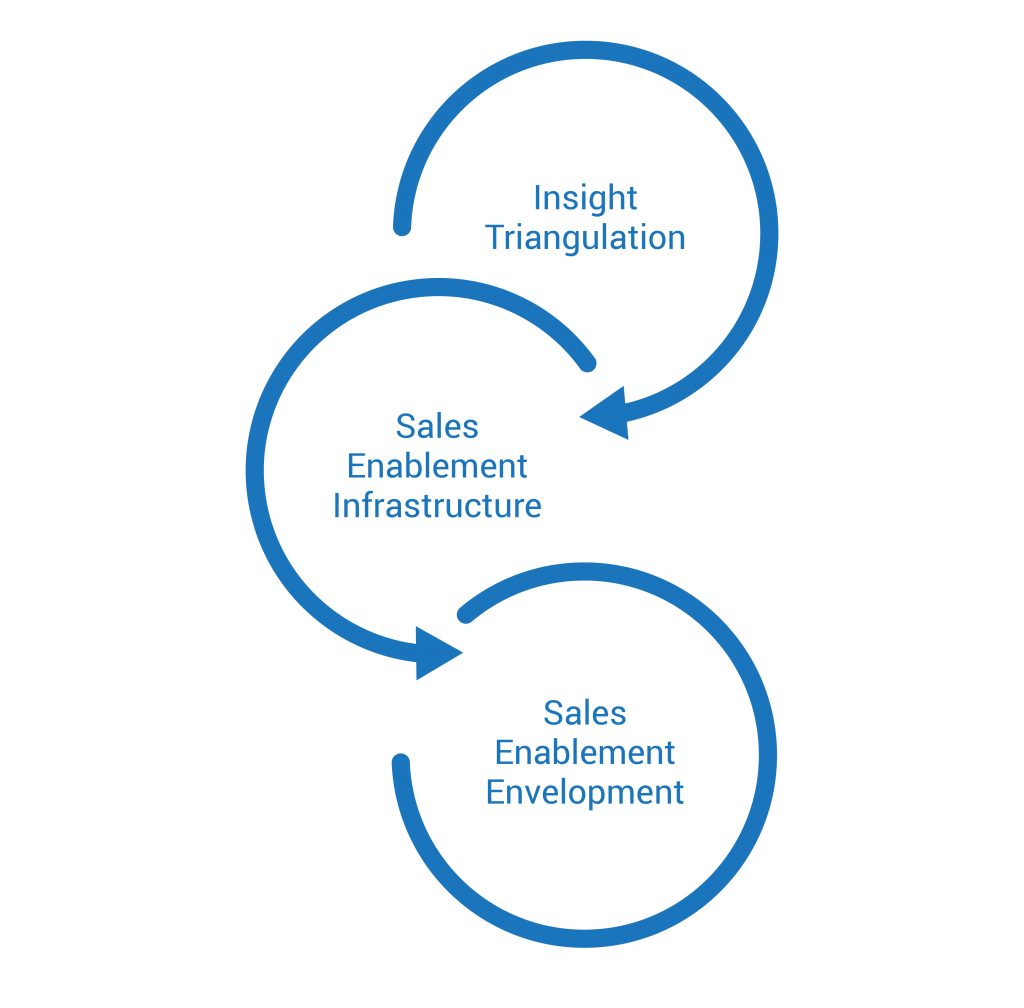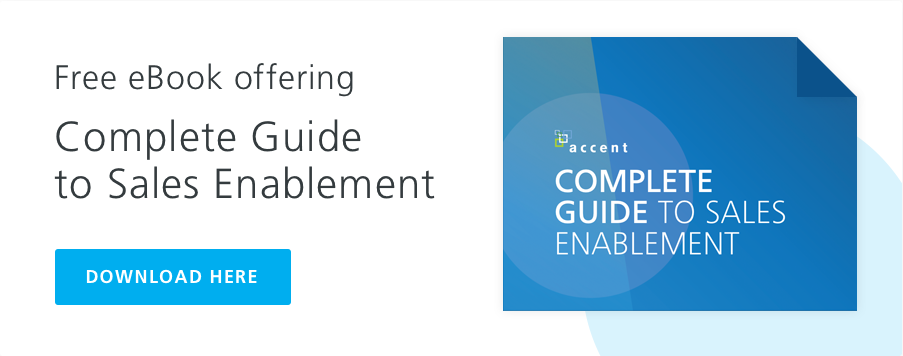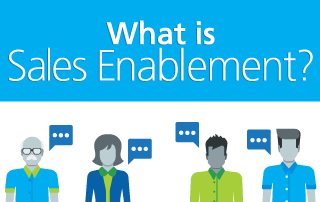sales-enablement
Sales Enablement Strategies
As we venture forward into the 2020s, we can expect to see continued volatility in shifting markets. Buyers are growing more informed. Increasing reams of data will become ever more accessible.
What is sales enablement?
It’s helpful to define sales enablement first before drilling down into strategy. Let’s start with some basics.
Market researchers have developed the following sales enablement definition: “an overarching dynamic capability that aligns varied firm resources to benefit the customer journey and selling productivity.”
You wouldn’t define carpentry by hammers, drills, and saws. You’d define carpentry by the core discipline of constructing things with wood.
In the same way, sales enablement isn’t a set of tools, like CRM software or data visualization software. Instead, it’s a strategy that leverages tools to produce information, insights, and actions that lead to success. More specifically, success in closing deals.
Here are three core sales enablement strategies:
- Collecting knowledge from across the company’s various departments into one place. Then, creating holistic, data-backed insights that sales teams can leverage to sell effectively.
- Developing a centralized hub where the sales force can access those actionable insights.
- Developing an infrastructure that aligns revenue-generating inputs with outputs to improve sales productivity.
Imagine having all these in one integrated framework that optimizes every stage of the sales cycle. How much more effectively could your team sell?
Sales enablement best practices will require the following actions from sales leaders:
- Maximizing organizational learning for the entire salesforce
- Helping the salesforce manage and respond to suggested changes in their sales practices
- Helping the salesforce adopt the sales enablement technology to support the strategies above

The Three Main Components Of Sales Enablement
Let’s break this down even further. It might be helpful here to take a look at the three main components of sales enablement. The sales enablement infographic below shows how each facet of the sales enablement process leads into the next. Then, we’ll drill deeper into each individual component.

Component 1: Insight triangulation
Insight triangulation is collecting information from different sources and synthesizing it into actionable insights.
These data points could include things like:
- Records of customer response
- Salesforce activities
- Internal metrics for resource utilization
All this data needs to be collected and translated into insights that will enable the sales team to:
- Assess the evolution of the customer journey
- Assess how current sales approaches are aligning with customer needs
- Assess how current internal activities are supporting and shaping sales cycles
Utilizing CRM software is a great place to start for effective insight triangulation. The key here is to have sales enablement software to help sales teams understand and visualize that data.
One sales manager interviewed in the study mentioned above described his CRM as “a big giant repository of stuff.”
All that “stuff” (raw data) only helps if it’s synthesized in a way that speaks to specific sales goals. (More on what to look for in tech-driven sales enablement solutions coming up in a bit.)
Component 2: Sales enablement infrastructure
The insights mentioned above form the foundation of an effective sales enablement infrastructure.
A sufficient sales enablement infrastructure acts as a single source of truth. It brings together all of the resources, activities, capabilities, and ideas to enable the salesforce. This is where the power of software and AI comes into play.
Sales enablement platforms should support and seamlessly integrate wide-ranging sales-related activities like:
- Lead generation
- Content management
- Email management
- Account planning
- CRM
- Onboarding
- Effectiveness tracking
The infrastructure must also be easy to use and easily accessible. Salespeople don’t like fiddling with technology. If it’s a bad user experience, getting buy-in will be tough.
Some software can also help sales leaders build activities that further support their sales reps, including:
- Sales enablement training
- Sales collateral development
- Win/loss analysis

Component 3: Sales support envelopment
Sales support envelopment discerns how the daily inputs of the sales team impact downstream results.
Understanding the impact of sales inputs on results facilitates better communication with clients.
An effective sales enablement strategy is going to take that knowledge and channel it into a comprehensive plan.
Sales Enablement Assessment: Three Fundamental Metrics For Success
According to market researchers, sales enablement plans are useful insofar as they show three core results:
- The channeling of data across the organization to support the sales team and improve sales productivity.
- A commitment to helping salespeople align their sales activities with the customer journey. This may include providing sales enablement tools, sales enablement training, and sales coaching.
- The seamless integration of several different organizational capabilities to optimize sales performance. These capabilities may include organizational learning, knowledge management, and customer relationship management (CRM).
Tips For Building Your Sales Enablement Strategy
By now, you should have a grasp on what sales enablement is, and what an ideal sales enablement strategy entails. Let’s drill down into the steps required to reach that ideal strategy.
We’ll start with another sales enablement infographic to visualize how the process works. Then, we’ll break down the five keys to successful sale strategies step-by-step.

Step 1: Sales enablement assessment
The first step is to examine how you’re currently supporting your salesforce. Productivity can only improve after assessing how things are going on the frontlines.
Sales enablement managers can start by asking themselves these key questions:
- Are my salespeople overwhelmed by all the input they receive and their assigned activities?
- Are our daily sales processes nuanced enough to respond to the shifting market? Or are they too complicated and taxing for the sales team to navigate?
- Are the company’s different departments communicating and coordinating their activities?
In this step, you’re playing the part of the researcher. You’re not trying to fix anything yet. You’re diagnosing and documenting your current sales operations and how they align with your goals.
The end goal is to identify weak spots and gaps. In our experience, these gaps will become recurring motifs in your conversations with sales reps.
Here are some common gaps or indications of weaknesses you’ll encounter:
- “Our data entry process is way too cumbersome and unstructured. I can never decipher notes left by another sales rep.”
- “I have no clue where to find up-to-date collateral for prospect conversations.”
- “It’s a full-time job keeping track of which deals are the most primed to close and how I should be prioritizing my days.”
Step 2: Sales enablement reconfiguration
Once you identify the gaps, it’s time to move to step 2. Sales leaders must now look at leveraging resources and technology to fill in the gaps and support sales goals.
Those resources and capacities may include:
- Budgetary allocations
- Marketing content
- Competitive insights
- Data management technologies
- Sales enablement training
To develop an effective sales enablement strategy, company leadership must support the sales team. And in turn, it must realign those resources with that goal in mind.
This is usually the most prolonged and arduous step in developing an effective sales enablement strategy. You may need to implement it in several different phases.
Step 3: Sales enablement platform rollout
Once everyone is sold on allocating resources to support the salesforce better, it’s time to roll new software or tools that fill in the gaps of Step 1.
This step can also be quite challenging. Getting team buy-in on new technology isn’t easy.
Sales enablement managers must present the new sales enablement platform in an approachable way. And, encourage the sales force in its usage.
The most important thing a sales leader can do is hammer home the value of sales enablement tools.
Reiterate how much easier this will make their jobs and workflows. Help reps paint a picture of their success using these new tools.
When you frame sales enablement software as a new piece of tech to learn, sales reps likely won’t receive it well. Yet, when you frame it as a means to an end — more satisfying work and more commission — it helps them see the holistic purpose of sales enablement.
Step 4: Sales enablement performance evaluation
By now, you’ve:
- Assessed your sales activities
- Allocated resources to align with sales goals
- Partially (or completely) rolled out new sales enablement solutions to support your strategies
- If you’ve made it this far, well done. It’s safe to say the most challenging parts are behind you.
Now, your job is to monitor and optimize your sales enablement processes. Asking the following questions is an excellent place to start:
- What are the returns on your sales enablement investments?
- Are your sales reps performing efficiently and effectively?
- Is sales productivity going up?
- Are you noticing increases in morale on your sales team?
- Do you find that prospects are moving through the funnel at a faster velocity?
Step 5: Sales enablement calibration
This final step involves fine-tuning your sales activities based on your performance assessment.
Calibrating your sales enablement strategy might be the fifth step in this process, but your job isn’t over.
Instead, like the sales enablement infographic above shows, it triggers an ongoing feedback loop.
How to Plan An Effective Sales Enablement Strategy
Be sure to set yourself up for sales enablement success by developing and applying a plan for implementing your strategy.
Here are five key questions to address when planning an effective sales enablement strategy:
What type of content do we need?
Assessing your content gaps will require lots of conversations. You’ll want to talk to customers, sales reps, customer service employees, and prospects. Perhaps you lack content that speaks to a particular pain point. Or, maybe a certain kind of content is especially performant in converting leads (webinars, for example), and you need to double down on those.
Most of the time, the best way to gather this data is through conversations. But don’t neglect search data from Google and analytics data on your most visited pages. These qualitative insights go a long way in making your content gaps clear.

How will our reps access the resources they need?
Information and resources must be available and accessible to the entire sales team. This means researching and electing the sales enablement platform that will best suit your sales team’s needs.
Take Accent Technology’s AI-driven Sales Enablement Solution as an example.
It easily and intuitively aligns sales teams with the resources they need. Also, it helps the sales team move deals forward by delivering relevant:
- Email templates
- Training materials
- Subject matter experts and coaching
How do we communicate the value of materials at different stages of the sales process?
This topic will be an essential part of your sales enablement training. Ensure that the sales team understands and knows how to optimize the data available to them via the new sales enablement platform.
Who will take the lead in the sales enablement process?
Bottom line: someone (or some team) must own sales enablement or it will go to the backburner. Before considering an outside hire, survey your existing personnel.
Who has the most experience with data-driven technological solutions? Who are the “visionaries” on your team—the most open to new ideas and ways of doing things? These are likely the best candidates for spearheading your new sale enablement initiative.
How will we measure success?
We saw above how crucial it is to never stop appraising and fine-tuning your sales enablement strategy. Before you implement that strategy, you need to have pre-defined metrics in place for measuring success.
These will always include things like sales wins and revenues, of course. But consider establishing metrics for important goals, like customer engagement with content.
Researching And Choosing Sales Enablement Solutions
We looked at a Gartner study on sales enablement platforms at the top of this post. It provides a helpful guide for organizations researching sales enablement platforms.
According to the study, look out for sales enablement solutions that offer these six core capabilities:
Digital content management
An effective sales enablement platform allows sales teams to create, store, curate, and distribute content to clients. This content should be accessible and shareable by the entire sales team.
Consider Accent Technology’s AI-driven Sales Enablement Solution. It allows sales teams to centralize, manage, and deliver content on any device.
This means less time hunting for up-to-date content, and more time with prospects.
Sales enablement training
Look for solutions that include a wide range of materials to support ongoing salesforce training. These may include:
- Quizzes and assessments
- Integrations with learning management system (LMS) tools
Sales coaching
Increasingly, sales enablement platforms are offering functions like:
- Live call recording and analysis
- Video coaching
- Peer-to-peer, manager-to-sales rep, and sales rep-to-manager feedback
- Analytics and engagement
An intrinsic component to an effective sales enablement strategy is access to data on client engagement. This may include insights into content opened and content shared, for instance.
Sales leaders also need ways to measure seller engagement at all different points in the sales cycle. Many platforms not only collect that data but interpret it to generate actionable insights.
Integration and platform
For maximum functionality, the sales enablement platform should offer seamless integration with other systems (like your extant CRM system), and with different types of vendors.
Artificial intelligence
Researchers are looking to AI as the way of the future in sales enablement. AI-driven sales enablement tools, such as the Accent suite of software, can identify and recommend the most effective sales content for any given point in the sales process.
AI-driven sales enablement software can also automate an array of sales activities (saving valuable time for client relationship building) and offer step-by-step guided selling.
By Accent Technologies
4th February 2021
Sales Enablement the Accent Way
Cross department alignment is a tall order. That’s why it’s so important to select a solution provider that will align with your specific goals and adapt to your process (not the other way around).
While we offer a breadth of capabilities that support the many functions Sales Enablement Teams, we strongly a “crawl, walk, run” approach is the key to most teams’ success.
What does that mean? It means we want to you where you’re at. And focus simply on what you need to get started. As your team grows, and as your needs evolve, we can explore the other bells and whistles. Learn more about our Sales Enablement platform, or contact us today for a live demo of one of our solutions.









